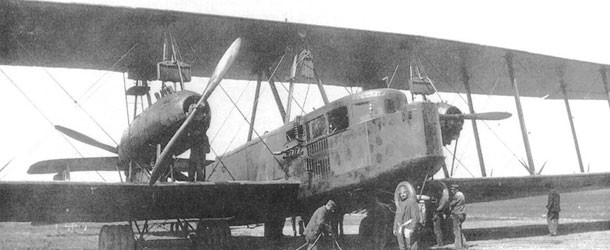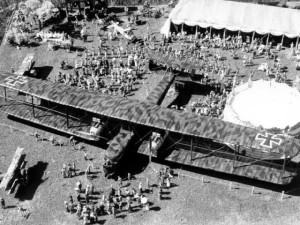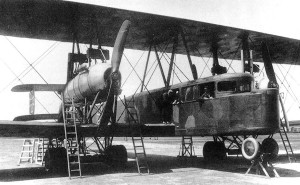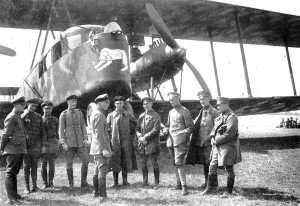The WW1 Wings of Glory Special Packs introducing the “giants of the sky” bombers Handley-Page O/400 and Zeppelin Staaken R.VI, will be released in early 2016. We have already presented the Handley-Page O/400 preview, so let’s learn more about the Zeppelin Staaken R.VI. The giant German aircraft was mainly used for night bombing raids and is renowned for the raids over London from the autumn of 1917 to the late spring of 1918.
The Zeppelin Staaken R.VI was the largest bomber in service on the Western front during the World War I, with its 42.2 meter (138.5ft) wingspan and a maximum bomb load of 4,400 lbs. It was powered by two pairs of engines, and had a maximum range of 500 miles. In flight, it normally had a crew of seven - commander, pilot, copilot, radio operator, fuel attendant and two mechanics. When on the ground it was attended by a 50-man crew, including a great range of specialists.
The R.VI was the first true production Zeppelin Staaken giant (Riesenflugzeug) bomber. The concept was envisioned by Ferdinand von Zeppelin in September 1914, and was developed with the creation of the Versuchsbau Gotha-Ost (VGO) consortium. The first giant built was the VGO.1, in April 1915. It was equipped with three Maybach Zeppelin engines; two pusher and one tractor. It had a 42.2 meters span, with a four-bay interplane strut layout for its slightly swept-back leading edge biplane configuration. Built for the German Navy, it served on the Eastern Front, and was later modified with two extra engines, but crashed during tests at Staaken.
The first three prototypes, called VGO, were constructed at the Gothaer Waggonfabriek A.G. site. In 1916, production moved to the Zeppelin Staaken Werke in the suburbs of Berlin, where several Zeppelin-Staaken R prototypes were built and evaluated. By the autumn of 1916, the R.V, R.VI, and R.VII versions of the same design had been developed, and Idflieg selected the R.VI for series production over the 6-engine R.IV and other R-plane designs.
The R.VI required a complex 18-wheel undercarriage to support its weight, and carried two mechanics in flight, seated between the engines in open niches cut in the center of each nacelle. The bombs were carried in an internal bomb bay located under the central fuel tanks, with three racks capable of holding seven bombs apiece. Although designed by Versuchsbau, only one of the 18 R.VIs built was produced by Zeppelin-Staaken, with the others commissioned to other manufacturers - Schütte-Lanz, Aviatik and Albatros Flugzeugwerke.
The Zeppelin-Staaken R.VI was powered either by four 245 hp (183 kW) Maybach Mb.IV engines or four 260 hp (190 kW) Mercedes D.IVa engines. The fuselage was similar to the previous aircraft, but the cockpit was extended forward, enclosed and glazed with a gunner's cockpit in the extreme nose. It was also improved with an aluminum alloy structure in the triple-finned biplane tail unit. One R.VI in a float-plane format was supplied to the Imperial German Naval Air Service, designated Type L, equipped with Maybach engines. It first flew on September 5th, 1917, but crashed during testing in June 1918.
Two units of Luftstreitkräfte were equipped with the R.VIs: Riesenflugzeug-Abteilung 500 (Rfa 500) and 501 (Rfa 501). The first R.VI, with serial number R.25/16, was delivered to Rfa 501 on June 28th, 1917, and was soon joined by R.26/16 and R.39/16. The giant bombers were first deployed on the Eastern Front, in Kurland, Russia, in several missions flown at night. In September, the Rfa 501 was transferred to Ghent, Belgium, for operations against both France and Great Britain. They were based in the St. Denis-Westrem airdrome, and later in the Scheldewindeke airdrome. The Rfa 500 was based at Castinne, France, with its primary targets French airfields and ports.
The German ‘Operation Türkenkreuz’ bombing raids against England started with the G.V heavy bombers daylight attacks in May 1917, which caused panic among civilians by bringing the experience of the war to the British citizens. But by August, the British had improved the defense against them, and the Germans turned to night-time raids, for protection against fighters and anti-aircraft fire. The giant bombers arrived in the Western front by that time, and were used in 52 missions, releasing 2,772 bombs and bringing destruction and terror to the British mainland.
The first mission of R.VIs over England was on the night of September 28th, 1917. Two R-planes and twenty-five Gothas began the raid, but due to poor weather conditions only three Gothas and the two R-planes dropped their bombs over the Thames estuary and parts of Essex and Kent (there was not sufficient visibility to reach London). The R.VI flew individually to their targets on moonlit nights, requesting directional bearings by radio after takeoff, then used the River Thames as a navigational landmark. Missions on the 340-mile (550 km) round trip lasted seven hours. No RV.I was lost in combat over Great Britain, but two crashed returning to base in the dark.
One of the Zeppelin Staaken R.VI featured in WW1 Wings of Glory was the R.28/16, commanded by Hauptmann Arthur Schoeller. It was produced by Schutte-Lanz, with four 245 h.p. Maybach Mb.1Ya engines and was accepted 12 February 1918 at Rfa.501. It became the Schoeller aircraft after the loss of the R.VI 27/16, in March 1918. When returning from England, the 27/16 fuel lines froze, and the R.VI's remarkable capability was shown by its long glide to a crash landing in Belgium. All the crew survived.
Flying the R.28, Schoeller faced another emergency on September 15th, 1918, after he had been assigned to command the REA, in Cologne. Just after take-off, a piston rod broke and the engine immediately stopped. Other failure followed, with a cylinder burst in another engine, forcing an emergency landing for the heavy-loaded aircraft. Schoeller managed the successful landing despite the darkness, but an engine continued to run even after its ignition had been cut. The R.28 ran into an escarpment and the fuselage broke in two. The crew was able to leave the aircraft just before it burst into flames, which detonated the full bomb load. Schoeller died in 1932, due to the long term consequences of war wounds.
The other RV.I coming in Wings of Glory is the R.33/16, an Aviatik built R.VI, with four 260 h.p. Mercedes D.lVa engines, flown by Hauptmann Erich Schilling, commander of Rfa 500. Schilling served in Immelmann’s FFA 62 and commanded the KG 3/18 and Kasta 18, before assuming the Rfa 500, in late 1916. He and four members of his crew died when the Staaken R.VI 52/17 crashed into a house near Villers la Tour early in the morning of 12 August 1918. They were returning from a short-range operation against Beauvais. The R.52 was a new machine, heavier than previous types, and pilots were unaccustomed to the different position of the cockpit. It was a pitch-black night over Villers la Tour when the R.52 side-slipped, caught itself and side-slipped again. The right wing hit the ground and fuel from burst tanks spilled over the hot engines and ignited.
Of the 13 R.VIs who saw action during the war, four were shot down in combat, while the majority of the losses were from crashes during landing, most due to reduced visibility, at night, or in foggy weather. Six of the 18 units built survived the war or were completed after the armistice.
Information sources: The Aerodrome, The Western Front Association, Aeronautical World, Wikipedia, Their Flying Machines, "The German R-Planes 1914-1918", G. W. Haddow & Peter M. Grosz, Putnam (1962).














Follow Us on